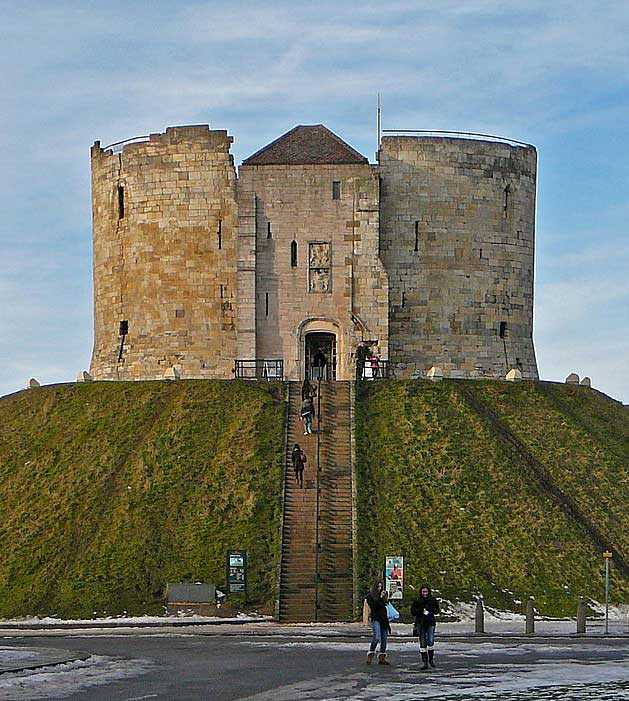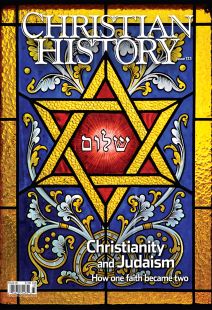TO EVADE DEBTS, YORK’S GENTRY INCITED A MOB AGAINST JEWS

[Above: Clifford's Tower, site of the York Massacre.—Tim Green from Bradford / [CC-BY-2.0] Wikimedia File:Clifford's Tower (5259021070).jpg]
ANTI-SEMITIC RIOTS marred the coronation of King Richard I of England in 1189. Jews were forbidden to appear at the coronation. When some brought costly gifts to the banquet that followed, the common people mauled them. They injured Benedict of York and forcibly baptized him. He soon died. Jocenus of York, a moneylender, escaped. Meanwhile a mob burned Jewish homes throughout London. Thirty Jews died in the rampage. Richard hanged a few of the ringleaders, but the tribulation of York’s Jews had barely begun.
Massacre was in the air. The following year warriors gathered to join Richard who was about to embark on a crusade. Would-be crusaders slaughtered Jews at Norwich in February and at Stamford in the early days of March.
On 11 March, violence commenced in York. This was the work of locals—including a number of poor churchmen—who had financial incentive. As William of Newburgh wrote,
Many people in the county of York took an oath together against the Jews, being unable to endure their opulence, while they themselves were in want and, without any scruple of Christian conscientiousness, thirsted for their perfidious blood, through the desire of plunder. Those who urged them on to venture upon these measures were certain persons of higher rank, who owed large sums to those impious usurers.
Fire broke out in York, probably set by the anti-Semitic confederates. While the citizens of York were distracted trying to save their homes from the flames, the conspirators broke into Benedict’s palatial house. They massacred Benedict’s widow and children and looted everything worth taking. Alarmed Jews took shelter in York Castle, a royal building, with the governor’s permission.
The mob next attacked and looted Jocenus’s mansion. Jocenus was already in York Castle. Afterward the mob forced any captured Jew to accept baptism or die. Meanwhile the governor of the castle went out. On his return, the Jews refused to readmit him, afraid he was double-dealing with them. He reported the situation to higher authorities and requested help. Armed men surrounded the castle. Egged on by a hermit, who portrayed the assault as a religious duty, they brought up siege engines.
The Jews held out until this day, 16 March 1190. Realizing that they were doomed, many of them listened to Rabbi Yomtob of Joigney, who urged them to commit suicide. Meanwhile someone set the roof of the castle on fire.
A few desperate Jews surrendered when promised clemency if they accepted baptism. The mob killed them anyway. About one hundred and fifty Jews died—either massacred, burned to death, crushed in the collapse of the building, or by suicide. The only besieger known to have died was the despicable hermit—crushed by a falling stone.
The conspirators continued pillaging Jewish homes. Local churchmen held records of loans in trust for the Jews. They were forced to hand these over and the debtors burned the papers.
King Richard was understandably outraged because he had guaranteed safety to the Jews. He ordered punishment. The massacre’s ringleaders fled to Scotland. Apart from a fine on York, no justice resulted. By 1195, Jews had begun to resettle York, where they prospered until exorbitant taxes ruined them. In 1290, King Edward I expelled all Jews from England.
—Dan Graves
_ _ _ _ _
Christian History # 133 explores the painful relationship of Christianity and Judaism.






